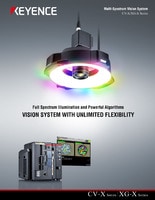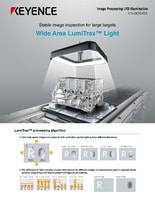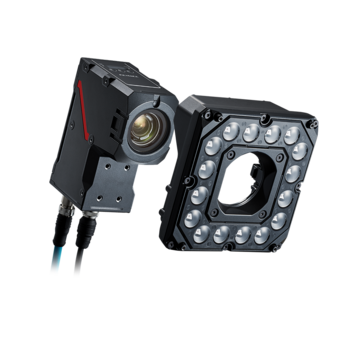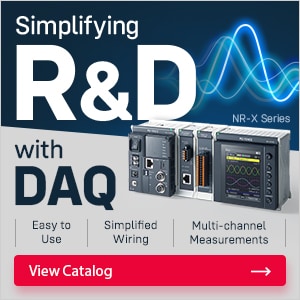Vision Systems
- Vision System with Built-in AI VS series
- Intuitive Vision System CV-X series
- Customizable Vision System XG-X series
- GigE camera and lighting for PC-based machine vision VJ series
- Inline 3D Inspection 3D Vision series
- 3D Vision-Guided Robotics 3D VGR series
- Line Scan Technology Line Scan series
- 2D Vision-Guided Robotics 2D VGR series
- LED Lighting CA-D series
- Lenses (for Machine Vision) CA-L series
- Machine Vision System Database VisionDatabase series
- 2D Measurement Inspection
- Optical Character Reading (OCR) and 1D/2D Code Verification
- Inline 3D Volume and Measurement Inspection
- Presence & Absence Inspection
- Flaw Detection
- 3D Vision-Guided Robotic Bin Picking
- High-Resolution Line Scan Cameras for High-Speed Imaging
- Automated Positioning and Alignment Systems Using Machine Vision
- Automotive
- Automation Equipment/Machine Building
- Electric Vehicles
- Medical Device Manufacturing
- Food/Beverage Packaging
- Semiconductor/Manufacturing Electronics
- Vision-Guided Robotics
- Solar
- Logistics
- Commodities
- Paper Manufacturing
- Machine Tools
- Electronic Device
- Printing
- Mining/Metals
- Fabric/Textile
- Tobacco
- Marine
- Aerospace
The Role of Image Analysis Software in Machine Vision Systems
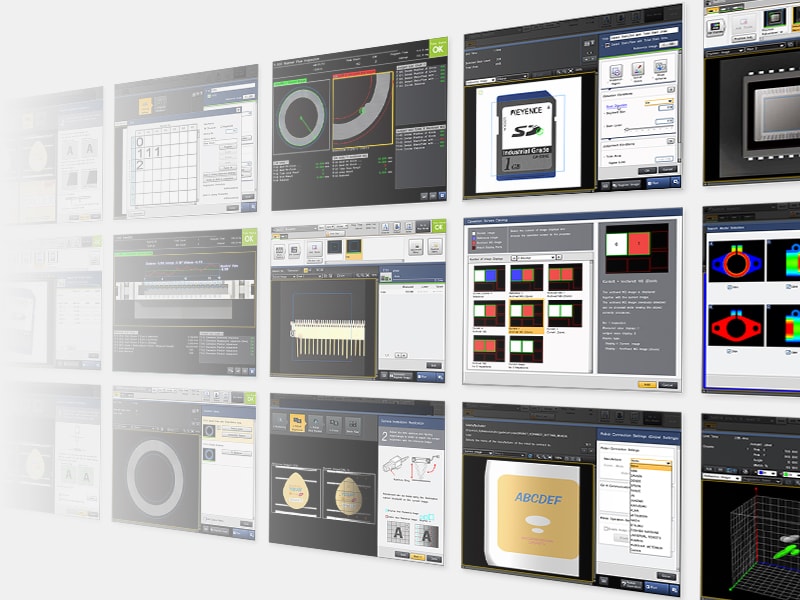
Modern manufacturing demands precision, speed, and efficiency—factors that machine vision systems deliver with remarkable accuracy. At the core of these systems lies image analysis software, an integral component that processes visual data to enable precise decision-making. Computer vision and image processing are transforming how manufacturers tackle problems. From defect detection to quality assurance, faultless production lines and more intelligent business operations are now possible.
Introduction to Image Analysis in Machine Vision
Machine vision relies on sophisticated software to interpret visual data, ensuring seamless automation in manufacturing. Image analysis software captures, processes, and evaluates data from images or video feeds, enabling machines to perform tasks traditionally reserved for humans. Manufacturers can meet strict quality standards, increase productivity, and cut waste thanks to this technology's real-time image interpretation capabilities.
One of the primary functions of image analysis in machine vision is defect detection. Systems equipped with image processing analysis and machine vision tools can identify flaws with incredible precision, helping prevent defective products from reaching consumers. The pharmaceutical, electronic and automotive industries have all experienced notable increases in operational efficiency as a result of integrating these capabilities.
We’re here to provide you with more details.
Reach out today!

How Computer Vision and Image Processing Enhance Machine Vision Systems
Computer vision and image processing technologies empower machines to "see" and interpret their environment. Such technologies employ algorithms to examine image data, spot trends and arrive at wise judgments. For instance, in manufacturing, they can distinguish between a correctly assembled product and one with missing components.
Pattern recognition, optical character recognition (OCR), which verifies printed text, and edge detection, which evaluates shapes and features, are essential features. Machine vision systems that minimize human error can be created by manufacturers while preserving high levels of precision by integrating image analysis software.
The Process of Image Processing Analysis in Machine Vision
Image processing analysis and machine vision rely on a multi-step process to interpret and act on visual data. First, cameras capture high-resolution images of the target object or area. Filters are then used to improve image clarity by eliminating distortions or lowering noise. Key features, like edges, textures, or colors, are identified by the system and compared to preprogrammed criteria in order to detect flaws or confirm quality.
Automated decisions based on the analysis are made by the system, like rejecting faulty products or setting off alarms. A simplified method such as this enables producers to uphold quality standards and increase productivity.
Discover more about this product.
Click here to book your demo.

Key Tools and Techniques in Image Analysis Software
Modern image analysis software leverages a variety of tools and techniques to process and interpret visual data with exceptional accuracy. A range of machine vision applications and industry-wide efficiency have increased due to recent advancements in tools and techniques. Some essential tools and methods used today are listed below:
- Deep Learning Algorithms
- Image analysis systems can learn and adapt through the analysis of large datasets thanks to deep learning. Algorithms are excellent at spotting patterns, like spotting faulty parts on a manufacturing line.
- For instance, deep learning can distinguish between acceptable and flawed products in semiconductor manufacturing, where imperfections are microscopic. By training on labeled datasets, systems improve over time, ensuring greater accuracy and reliability.
- 3D Imaging
- Methods that use 3D imaging help analyze complex shapes because they allow for depth perception. For example, in the automotive industry, 3D vision systems inspect parts like gears and pistons to ensure they meet precise specifications.
- Color Analysis
- In sectors like food and beverage, where minute variations in color can signal contamination or quality, color analysis tools are essential. For example, systems in a beverage plant may analyze the color of liquids to ensure consistency across batches.
- Thermal Imaging
- Thermal imaging is essential for spotting anomalies that are not visible to the naked eye because it can identify heat signatures. Thermal cameras are used in electronics manufacturing to detect solder joints or overheating components. In a similar vein, the pharmaceutical industry makes sure that goods are transported and stored in the proper temperature range.
- Edge Detection
- Edge detection algorithms are used to identify object boundaries within an image. Commonly used in packaging to guarantee that seals are intact or that labels are aligned correctly, this technique can be helpful. Applications that scan QR codes and barcodes for precise data capture are also supported by edge detection.
- Optical Character Recognition (OCR)
- OCR extracts and interprets text from images, enabling real-time verification of printed information. In the pharmaceutical sector, OCR ensures that expiration dates, batch numbers, and regulatory markings are accurate and legible.
- Blob Analysis
- Blob analysis identifies and measures regions within an image that differ from the background, such as spots, holes, or foreign objects. For example, in the food industry, blob analysis detects contaminants or ensures uniformity in product shapes, such as cookies or candies.
- AI-Powered Real-Time Analytics
- AI enables real-time data analysis and prompt decision-making for production line optimization. For instance, AI-powered systems in e-commerce warehouses identify and categorize items as they move along conveyor belts, streamlining sorting processes.
See the benefits firsthand by signing up for a free trial now.
Free Trial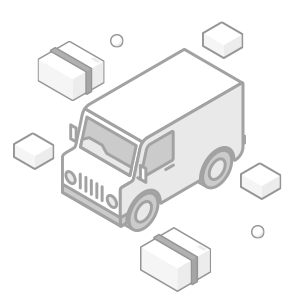
Machine Vision-Based Defect Detection Using Image Processing
Defect detection is one of the most critical applications of machine vision-based defect detection using image processing. Before any product is delivered to customers, this procedure guarantees that it satisfies quality standards. Systems can identify surface flaws like dents or scratches, size or shape errors, and assembly problems like misaligned parts by examining visual data.
For example, in semiconductor manufacturing, even microscopic defects can render a product unusable. Image processing analysis and machine vision tools excel at identifying these flaws with unmatched accuracy.
Leveraging Image-Based Data for Larger Business Decisions
The data generated by image analysis software is not just useful for defect detection; it drives broader business strategies. Equipment failures and bottlenecks can be identified and improved by analyzing production trends. Costs are decreased, and customer satisfaction is increased when this data is incorporated into predictive analytics.
In short, the role of image analysis software in machine vision cannot be overstated. Today, manufacturing relies heavily on technology and systems, and the future looks no different. To improve accuracy, reduce waste, and increase OEE, businesses must use computer vision and image processing tools.
KEYENCE is a leader in image analysis and machine vision systems. Contact us today to discuss and learn more.
Contact us to learn more about how our advanced technology can help take your business to the next level.
Contact Us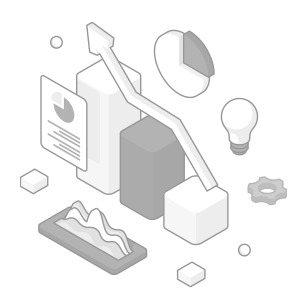
Related Products
Applications
- 2D Measurement Inspection
- Optical Character Reading (OCR) and 1D/2D Code Verification
- Inline 3D Volume and Measurement Inspection
- Presence & Absence Inspection
- Flaw Detection
- 3D Vision-Guided Robotic Bin Picking
- High-Resolution Line Scan Cameras for High-Speed Imaging
- Automated Positioning and Alignment Systems Using Machine Vision
Industries
- Automotive
- Automation Equipment/Machine Building
- Electric Vehicles
- Medical Device Manufacturing
- Food/Beverage Packaging
- Semiconductor/Manufacturing Electronics
- Vision-Guided Robotics
- Solar
- Logistics
- Commodities
- Paper Manufacturing
- Machine Tools
- Electronic Device
- Printing
- Mining/Metals
- Fabric/Textile
- Tobacco
- Marine
- Aerospace

